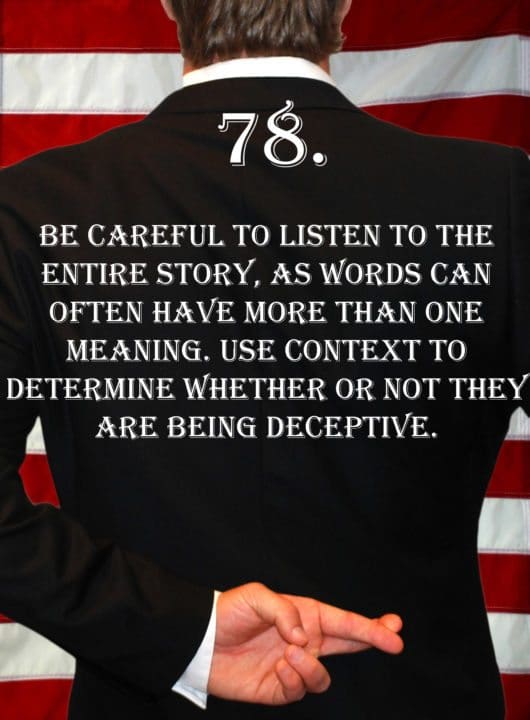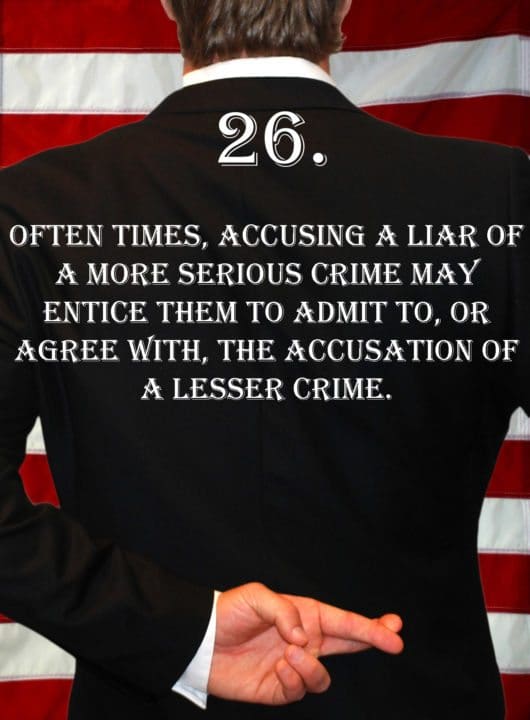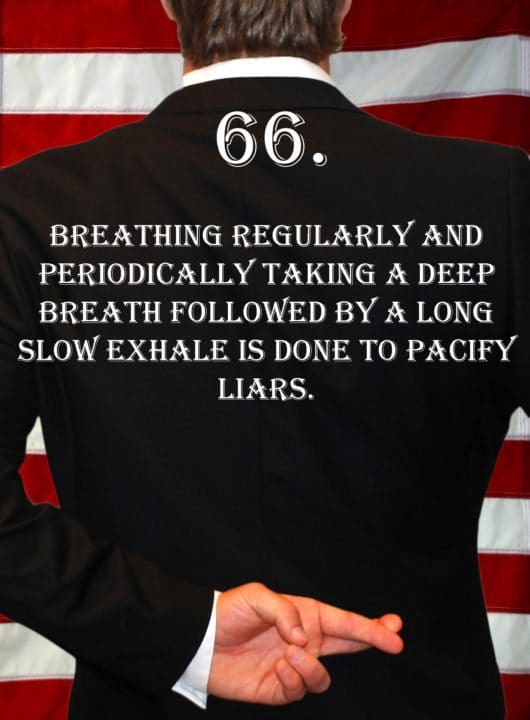
Deception Tip 7:
It is essential to look for clusters, or patterns, of behavior when detecting deception. Liars always display more than one sign.
Listen To The Podcast!
E7 – Clusters of Behavior – Deception Tips Podcast – Click Here To Subscribe
Podcast Transcript
Hello, and welcome to the Deception Tips Podcast, where you will learn amazing cues to detect deceit that will help you read people like never before. I’m your host, Spencer Coffman. Let’s get started.
Thanks again for tuning in to the Deception Tips Podcast. Today is Deception Tip #7 and before we get into that let’s talk about what we went over last week on Deception Tip 6.
We discussed a sign of deception where when people feel vulnerable or exposed they tend to cover vulnerable and sensitive areas of the body. This is common. Anytime someone tells a lie and they are about to be found out, it is a natural human behavior. Covering up oneself and protecting oneself when they feel like they are being exposed.
The very nature of the word “exposed” brings this. When you’re exposed, I mean what do you think of if I say “so and so exposed.” Or you see celebrity headlines all the time. They’ll say they’re exposed. Things are uncovered. That means that everything is out there for the world to see.
And when you call a liar out and, maybe not call them out, but you’re starting to get onto their lie or pick up on things that aren’t true or you’re pointing out holes in their lie or inconsistencies in their story, they start to feel very exposed.
You may not know that they’re lying yet. You still may be putting it together, but in their mind, they’re thinking, “Oh no. He’s onto me. He’s got me.” Or “That person’s found out. I’m going to get caught.” They are feeling exposed and when people feel exposed they also feel very vulnerable and a typical human reaction to being exposed and vulnerable is covering up any areas of our body that we don’t want people to see. Now that typically the genital regions or any parts that we like to keep private.
By definition, all these words are pretty much self-explanatory, so there’s really not a lot to talk about, not a lot to summarize here. But basically, when people feel vulnerable/exposed when their lies are about to be found, they are going to cover any of those vulnerable and sensitive areas on their bodies.
It’s a natural human, natural animalistic, reaction. Animals do the same thing. They tend to cover up. They tend to hide. Humans’ basic mammalian instinct is to cover that and it can be seen, and done, in a variety of ways.
Sometimes people can fold their arms. They’ll be covering the chest area. Sometimes they can put their hands on their lap covering the groin area. Other times they may have a book or a newspaper. It can be done where people turn a chair backward and sit in it that way or they even stand behind a chair or a couch.
They may stand behind a desk. A lot of times, a desk in an interview is a form of vulnerability and protection. Anything that goes between you, the target, the intended target of the lie, and the liar. Anything that goes between those two people that is more than normal, everyday clothing attire, is considered and can be considered, some form of deceptive behavior with covering and feeling vulnerable.
So that is that. Hopefully, you remember more from our podcast last time. If not, go ahead and listen to it. A lot of good information there, as always. And today, we are moving on with Deception Tip 7. We are going to talk about something that we’ve been hinting at all along.
It’s something that in all these past episodes, I’ve brought it up almost every time because it is so very, very important when detecting deception. And the reason I’ve waiting until now to talk about it is that you needed to learn and understand some other signs of deception in order to get here because today we are going to talk about behavioral clusters and patterns of behavior.
These are specific groupings of signs of deception that come together and when you see them, you can be certain. There is no question. It is beyond a doubt that this person is lying when these groups happen because, as we’ve talked about, when you see one sign, like when we said someone folds their arms, they could be lying but they could also be cold or they could also be covering up something. We don’t know. There could be a number of reasons. Maybe that’s just how they’re comfortable sitting.
When someone’s pupils dilate. When we talked about that. That could happen for any number of reasons. Lighting, chemical induction. We don’t know. They could be lying. All these other things can be happening for a variety of reasons but when you see a cluster, now you know they’re lying because multiple things have happened.
It’s like when people investigate. A lot of cops and law enforcement, when they investigate something, and it’s just one thing or one piece of evidence. Or attorneys, when they find something, that they can explain that way. It’s circumstantial. It’s a coincidence. Whatever the case may be.
However, when there are multiple facts and multiple signs of evidence, they come together and now it starts to look like something. It’s almost irrefutable. You say, “Hey, I’ve got this.” Oh, but that’s one thing.
I can easily explain that away. Then you come up and say, “Hey, but I’ve also got this, this, this, and this.” Now they start talking about a plea deal because they know they’ve got so much evidence on them, “Look. We’re not going to win this.” So with clusters of behavior, you know that there is so much going on that you KNOW they’re lying.
It’s an irrefutable fact with a cluster. This is why, as I’ve stated over, and over again, you have to look for clusters and patterns of behavior. Because when you see these patterns, you know. It’s like a big red light or a neon sign that says “Yes! They are lying,” and you saw it and you can be certain of it because you saw the clusters and the patterns.
Of course, we have only gone over a handful of signs of deception and there are many, many more out there and the signs that we’ve gone over, you may not see altogether in a cluster because we’ve gone over signs of different areas. Folding the arms is on the body. Dilating the pupil is with the eyes. Contradictory behaviors are with speech and body language. Physical tasks are the body. So I mean you’re going to see a lot of these individually anyway and in terms of clusters, you’re going to see additional signs we haven’t covered yet.
Like folding the arms, backing away. Now folding the arms could be a cluster in and of itself because when someone folds their arms, if they’re a female, if they fold them higher on the chest, now it could be a sign that we covered last time of covering a sensitive region because they could be covering that sensitive area AND folding their arms. We stated, that typically, women fold their arms a little lower, like on the belly area because of their anatomy. Well, if they fold them higher that’s two signs. So that could be a cluster of its own.
Add that to, maybe backing away, and now you added another behavior and that’s a cluster. We haven’t gone over backing away, but now you know that’s a sign of deception. That’s been mentioned before.
So these clusters are something that, as you continue listening to these podcasts, you’re going to learn a lot more signs of deception. We’ve got 101 episodes. That’s 101 signs of deception. You’re going to learn a heck of a lot and when you hear all of these, you can start putting them together in clusters and patterns of behavior.
With that, here is the tip of today. Deception Tip #7: It is essential to look for clusters or patterns of behavior when detecting deception. Liars always display more than one sign. Here it is again. It is essential to look for clusters or patterns of behavior when detecting deception. Liars always display more than one sign. It’s as simple as that. No matter what happens, liars WILL always display more than one sign.
This is because, as we’ve stated, the unconscious is super truthful. It can’t stand telling a lie. It has to tell the truth. It has to let the truth be known. It needs to be honest. Whereas the conscious is incredibly deceptive and self-serving. It can be trained to be non-self-serving and more selfless and geared toward other people but inherently, the nature of the human being or animalistic is: SURVIVE.
In order to survive, you need to do things that help you obviously. Then you do things to help others but with the ulterior motive of helping yourself. Why would you help them get food? Well because then I’ll be able to get some of the food too. That’s just how it was when you needed to fight to survive. The survival of the fittest.
So when it comes to the unconscious and the conscious, we’re still in that basic instinct. Inherently, when you boil it all down and strain out everything and you get down to the base metal, that’s what it is. Its survival and inherent characteristics.
The unconscious is truthful and the conscious is deceptive. So when the conscious tells a lie, the unconscious is fighting to get the truth out and if you can consciously train yourself to see and notice these behaviors, these clusters, and patterns, then you will be very, very well able to detect deception.
I’m going to get into some of these clusters and what they may look like, but before that, we’re going to take a break.
Do you ever wonder if that smile from the person you’re interested in is sincere? Or is it merely polite? Spencer knows. He’s published groundbreaking research on smile detection and his books can give you more insight into what that person is really feeling.
Obviously, as we go through this podcast series, you are going to find out many, many more signs of deception and you are going to be able to put these clusters together on your own and come up with certain behavioral patterns that can form a PERFECT sign of deception. As a group, not just a single sign.
Like we said with crossing the arms and backing away, that’s seen as one behavior. If I fold my arms and take a step back, people don’t really break that down and say, “Well what did he do? He folded his arms. He took a step back.” Maybe my breathing changed. Maybe I looked towards the exit. So now we’ve added all these different behaviors.
Maybe instead of folding my arms, I crossed them in front of my waist and took a step back. Now we’ve added another sign in there. In that, I crossed my arms. I put one hand in front of another and put them in front of my waist. Then I took a step back and looked toward the door. My breathing also changed. How much happened there? Typically you would see that as, that’s just an everyday, normal occurrence.
But if you’re paying attention, we’ll break it down. I folded my hands putting one hand on top of another. Covering a hand could be a soothing gesture. That’s one. Putting that in front of my groin area. That’s two. Taking a step back. That’s removing myself. That’s three. Looking towards an exit. That’s four. My breathing may have changed. That could be five. What happened with my eyes. That could be six. That is six observable signs of deception that could happen right there, that if you’re not paying attention to or you’re not looking at it as deception or potential for deception, you could miss it.
It could seem like normal behavior but if you KNOW what you’re looking for, that’s right there. That simple thing that maybe only took me a second to perform. To put my hands down, take a step back, all that stuff happened in a matter of one, maybe two seconds. But it was six or more signs of deception!
This is why it is essential for you to learn these signs and start recognizing them on yourself and then on other people. If you can start noticing it on yourself, you’ll be much better able to see it on other people.
Now that doesn’t mean I want you to go out and start lying so you can see if any of these signs start to happen. No. If you learn a sign, stand in front of a mirror and do the sign. Then you can see it on yourself and if, in everyday conversation, you notice yourself putting your body in that position, or doing those things, stop for a minute and think about it.
“Why did I do that? Did I just tell a lie?” You may not know that you were telling a lie. We talked about that before and how you could be telling a lie but not consciously know you’re telling a lie, but your unconscious knows.
So if you notice any of these signs on yourself, don’t get scared, but instead, think of it as a great opportunity because now you can think about it and do a little introspection and be like “Why did that happen? Why did I do that? Was I cold? Was I scared? Did something happen? Well, I don’t think I told a lie. Let me see. Did I? What did I remember? What did I say?” Maybe you saw something that was deception.
This is another curveball because if you observe stuff that may be deceptive or offensive and you don’t agree with it, you think it’s phony or false, you may take on deceptive behavior. Because your unconscious doesn’t agree with what your conscious just saw and interpreted. That is another thing to keep in mind but anytime you do any of these things, think about it. And why did you do it?
Because now, you will be able to understand them so much more, and then when you start to see them on other people you’ll be able to think about it with an open mind and say,” OK, well when I saw it on me, and I thought about it, it could’ve been for any number of reasons.” And when I see it on them, now if you can put that over there and think that it could be happening to them for any number of reasons.
So this will really help you because now you won’t really be dead-set and narrow-minded on “If someone folds their arms, they’re lying.” Because that’s not the case. You need to have an OPEN mind about this and think that there could be a number of possibilities for any of these signs and, if you keep that open mind, then you will recognize clusters and patterns a lot more easily.
You’ll keep that open mind and you’ll say, “Well, he folded his arms that doesn’t mean he’s lying he could be cold.” Boom. Now he took a step back. “Ok, well, maybe he’s getting ready to leave.”
Oh, now he moved his hands in front of his groin area. “Ok, that’s three right there. Now, something must be going on.” And you can watch for that and notice when people are lying by seeing these clusters and patterns of behavior.
This is why it is essential for you not to get locked into one sign always being deception. ALWAYS assume that someone is telling the truth until you notice multiple things. They’re innocent until proven guilty and that is the way it is. Learning how to read people and detect deception is highly important.
I want to thank you for listening to this podcast and I encourage you to share it with your friends, subscribe to the feed, follow the Deception Tips blog, take a look at the books I have available, and, as always, tune in next week for a new Deception Tip.
Video Transcript
Hey guys, my name is Spencer Coffman. Thank you for watching the Deception Tips Videos, they’re all about teaching you how to read people and detect deception so that you will know if you are being lied to.
Today, we are going to talk about patterns and clusters of behavior. This is something that you’ve heard me talk about if you’ve been watching these videos If you’re a regular watcher or viewer, then you’ve heard me mention clusters and patterns of behavior several times.
In addition, if you listen to the podcast, you watch the deceptions tips blog, or follow, read the e-books, or any of that other stuff, or if you’re educated when it comes to body language and deception. You no doubt have heard of clusters and patterns of behavior. The reason is because they are so very important. In fact, it is the most important aspect of reading people and detecting their emotions and relating to them and watching them and understanding what is really going on in their mind. What they’re thinking and how they really are behaving. Because clusters are signs and groups of multiple single behaviors when they’re put together they have a more significant meaning.
So here it is, Deception Tip number 7: It is essential to look for clusters, or patterns, of behavior when detecting deception. Liars always display more than one sign.
Now I wanted to say something one more time here, liars always display more than one sign. That is a key thing for you to remember. They always display more than one sign. It’s not like you’re going to miss it, it’s not like you’re going to miss it and then all of a sudden you’ll say, “aww man, now I’ll never find the truth.” No. There will be more than one sign.
They’re going to continue to express signs of deception as long as they are lying. As long as the conscious is telling a lie, the unconscious will be fighting to put that truth out there, and there will be signs happening all over the place. And it is through realizing and learning about each of these signs that you will be able to tell. And if something is happening, you’ll be able to see certain signs and you’ll put one and two and three and four and you’ll say, “wow, those kind of go together. That must mean they’re lying.”
Now, this isn’t something that you’re going to sit down and write out and itemize and consciously think about and take a long time with. No. This is something that’s going to happen fairly quickly. You may see someone fold their arms and in your mind, right away, you’re going to say, “okay, arm folding. They could be cold, they could need security, it could be a comfort gesture, or they could be lying. They could be defensive or withholding.”
And then, that’ll happen in a split-second in your mind. Then you’ll see, okay now they’re leaning back. Okay, leaning back, that takes away uh, comfort. It could take away cold, it could be certain others. Learning back, that sign in itself means withdrawing, pulling away. Stepping further back, they may not like something, they’re resisting. Like if I give you something gross to try, you’re not going to put it in your mouth right away, you’re kind of going to shy away from it a little bit, so they’re going away. Plus folding the arms.
Then, if you have other signs into that like maybe their face is doing something, maybe they said something, Those are clusters of behavior. And it happens very quickly. These signs and these patterns happen very quick. Each different sign could be a split second. Especially if it’s a certain micro expression or an emotional expression on the face. Such as the pupils dilating or maybe their eyes widen, as in surprise, something like that. A fraction of a second. But you may not see, so you don’t have to worry if you missed a certain sign. Or if someone folds their arms, and you noticed, like, maybe three seconds later.
“Oh wait a minute, they’re folding their arms. I wonder what I said three seconds ago to make them fold their arms?” But don’t worry, because if you keep talking to them and you keep engaging, or if they keep watching a certain thing, then you’ll know that there are other signs that come about. So maybe you’ll keep talking and you bring up something again and they do something else. Maybe they shift their weight, or maybe they stand on a different foot. Or maybe they lean back, or they turn away, or any different thing that could happen.
If you continually go through conversation with other people, there will always be more than one sign, because people don’t stand still. If you notice, you watch the replay of these videos, I’m not standing still here. My head is moving, my hands move a lot, I’m always kind of bobbing back and forth. Standing still is very difficult to do. In addition, if someone stands super still, it’s pretty boring to watch them. There’s really nothing going on, they just kind of look like a talking head. It’s boring. I mean, there’s no energy, there’s no life there. So, when people stand still that’s also a sign in and of itself. But the main thing is always look for more than one sign. Keep an eye out for clusters and patterns of behavior.
So if this is your first time watching these videos, I would love to have you subscribe to the channel on YouTube. In addition, if you have any questions or comments, leave them there as well. Also, if you’d like more information, we’ve got books, blog posts, podcasts and all kinds of stuff available on SpencerCoffman.com. That is dedicated to teaching you exactly what every body is saying.
Until next time.






